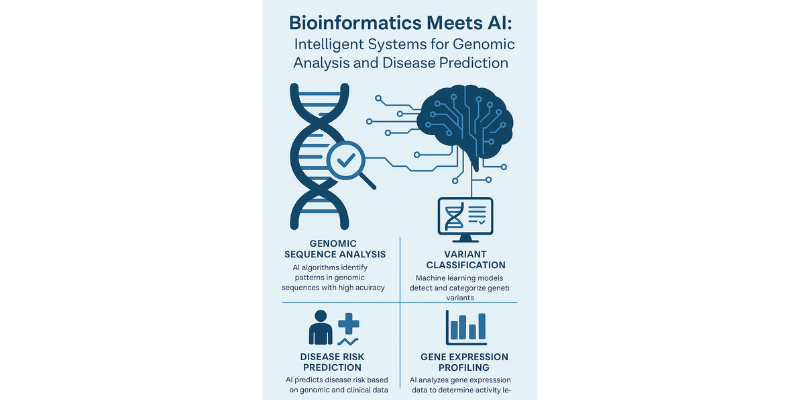In today’s era of precision health and personalized medicine, bioinformatics and artificial intelligence (AI) are two disciplines coming together to transform the genomic analysis and disease prediction landscape. Human genome, consisting of more than 3 billion base pairs, is a repository of information that may be used to predict disease susceptibility, decipher hereditary diseases, and create personalized therapy. But big numbers and the complexity of genomics are a challenge. That is where artificial intelligence, and more particularly machine learning (ML) and deep learning, comes in—allowing clever systems to read genomics at low cost, model, and predict states of health.
This article investigates the interactive bioinformatics and artificial intelligence interface to smart genomic analysis and disease prediction, with an emphasis on statistical information, practical application, and healthcare guidance to the future.
The Genomics and Bioinformatics Rise
Genomics has become one of the pillars of contemporary biology and medicine. After the fruitful completion of the Human Genome Project in 2003, which was well over a decade old and had taken a budget of around USD 2.7 billion, the price for sequencing a human genome declined spectacularly. Nowadays, with technological advancements, it is possible to have a whole genome sequenced for less than USD 200, and some platforms already guarantee $100 genome sequencing in the near future.
As more sequencing data are being created, bioinformatics became an emerging field that converges biology, computer science, and statistics in order to process and interpret biological data. Biologic information itself will contain 40 exabytes (40 billion gigabytes) by the year 2025, so there will be the need for scalable, smart systems to analyze and process it.
AI in Bioinformatics: A Natural Synergy
Artificial intelligence offers computing power and learning capacity so that they are able to detect difficult patterns in big data sets. Artificial intelligence augments a variety of genomic processes such as:
Sequence Alignment and Annotation
Artificial intelligence software like Google’s DeepVariant employs deep learning to better detect genetic variants than traditional methods.
Gene Expression Prediction
Transcriptomics data can be fed to neural networks to enable predicting upregulated or downregulated genes for certain conditions.
Variant Calling and Interpretation
Machine learning algorithms forecast Single Nucleotide Polymorphisms (SNPs) and other pathogenic mutations in cancer, Alzheimer’s, or orphan diseases.
Epigenomics and Regulatory Networks
Machine learning algorithms such as DeepSEA and Basset forecast the impact of non-coding variants on gene regulation, “reading junk DNA.”
Disease Prediction using AI-Driven Genomics
AI models that have been trained on genomic data can be used to create predictive diagnoses for multifactorial diseases, e.g.
Cancer Prediction and Classification
Deep learning models can analyze somatic mutations to predict cancer subtypes. AI models such as IBM Watson Genomics utilize genomic data along with clinical databases to recommend targeted treatment.
Cardiovascular Diseases (CVD)
Polygenic risk score ML models can predict risk to disease like coronary artery disease with 85% accuracy.
Rare Genetic Disorders
Use cases of AI like Face2Gene scans facial features as well as genomic information to diagnose rare syndromes that otherwise remain undiagnosed.
Neurodegenerative Disorders
AI technologies are assisting in the identification of biomarkers and genetic origin for Alzheimer’s and Parkinson’s, thus facilitating early diagnosis.
Infectious Disease Genomics
Genomics with the support of AI during the COVID-19 pandemic helped to track mutations, identify vaccines, and understand host-virus interactions.
Case Studies and Global Initiatives
The UK Genomics England 100,000 Genomes Project interprets cancer and rare disease sequencing information into actionable intelligence using AI, speeding diagnosis and personalized treatment.
US NIH All of Us Research Program attempting to sequence more than 1 million genomes and using AI interpretation of multi-omics data (genomic, proteomic, metabolomic) in the public good of carrying out public health research.
Google DeepMind AlphaFold smashed record protein folding prediction benchmark resolving 50-year challenge of folding allowing understanding of gene function and drug design.
India’s GenomeIndia Project being led by Department of Biotechnology (DBT) will sequence the genome of 10,000 members across various ethnic populations and prepare datasets of maximum applicability to risk prediction of disease that would be Indian-centric.
Industry Growth and Market Statistics
The bioinformatics industry worldwide was USD 11.5 billion in 2022 and shall be USD 30 billion by 2030 with a CAGR of 13.2%. Likewise, the growth rate of the AI genomics market is extremely high:
From USD 500 million in 2021 to USD 5.6 billion by 2030.
More than 60% of biotech firms are now incorporating AI tools into their R&D pipelines.
Startups such as Tempus, Helix, PathAI, and Genentech AI are raising hundreds of millions of dollars of capital to drive genomic research using AI.
Even in India, there are new entrants such as Strand Life Sciences, MedGenome, and Genotypic Technology, making heavy investments in AI-based genomics for cancer diagnosis, diabetes diagnosis, and genetic disease diagnosis.
Benefits of AI-Bioinformatics Convergence
Personalized Medicine: Drugs tailored to individual’s own genetic profiles.
Early Disease Diagnosis: Extra disease screening based on inheritance or predisposition.
Lower Costs: Smarter analysis and fewer trial-and-error treatments.
Faster Drug Discovery: AI prediction from drug-target interaction based on genomic signature.
Improved Public Health Surveillance: Monitoring disease spread and mutation using AI and sequence data.
Pain Points and Ethical Problems
While it promises great benefits, AI bioinformatics suffers from problems
Privacy of Data: Genomic data are confidential data. Adherence to GDPR and HIPAA norms is required.
Algorithmic Bias: Western-trained AI models will not be applicable to multicultural populations, particularly Asia and Africa.
Interpretability: Doctors need to interpret AI-derived decisions so that they can rely on and gain from them.
Infrastructure: Cloud and high-performance computing infrastructure is required to store and process enormous genomic data sets.
Explainable AI (XAI) and federated learning are being deployed to advance transparency and data sovereignty.
The Road Ahead
Integration of bioinformatics and AI is a revolution in medicine turning genomics into an actionable science. By 2030:
50% of clinical diagnoses will be guided by AI-processed genomic information.
AI-powered genomic decision support systems will be integrated into standard clinical work flows.
Genomic literacy will be as natural as clinical competence in clinicians.
Real-time disease per capita risk assessment using wearable technology and genomic phone apps will be the norm.
This merging of artificial intelligence and bioinformatics is transforming the future of healthcare. These intelligent systems with the capacity to read the genome are no longer fantasy—they are a working reality constructing disease prediction, diagnosis, and treatment. With the cost of sequencing falling and artificial intelligence continuing to advance, the two together will drive the dawn of an era of precision medicine when doctors can really have predictive, personalized, and proactive care.
Prepared by
Dr. Anam Giridhar Babu,
Associate Professor, Department of Basic Sciences, SR University, Warangal 506371, Telangana, India.





